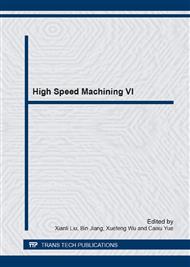p.155
p.160
p.167
p.175
p.180
p.186
p.191
p.197
p.203
Investigation of Tool-Wear and Surface Roughness in Turning Ti6Al4V under Different Cooling Lubrication Conditions
Abstract:
In titanium alloy machining, under different cooling lubrication conditions, the variation of tool wear and chip morphology have a certain effect on the surface roughness. Under different cooling lubrication conditions, in order to analyze the variation of tool wear, chip morphology and surface roughness, the surface roughness values are measured and the variation in tool wear and chip morphology are observed, and then the interaction relationship between the tool wear and the chip morphology is analyzed. The results show that the tool wear and chip morphology influence on the surface roughness. Under different cooling lubrication, the rake face wear do not change significantly, but wet cooling and MQL play a protective role for the flank face wear.
Info:
Periodical:
Pages:
180-185
Citation:
Online since:
July 2014
Authors:
Keywords:
Price:
Сopyright:
© 2014 Trans Tech Publications Ltd. All Rights Reserved
Share:
Citation:


